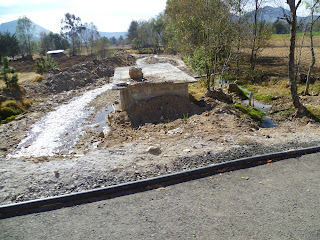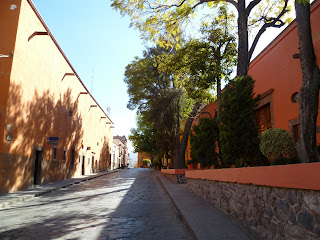We are now in Patzcuaro, a familiar base from which to spend a couple of quiet days before we head home on Sunday. I'm excited about getting back to Cori, our home, our comfortable beds, eating fresh fruit and juices, home cooked meals and our friends in no particular order. We also can't wait to feel the warm and humid air again. It's been cold, the air is dry and our skin began to show the signs of overexposure to sun with the dry air....kind of like a raisin, we've been hung out to dry in the wind and sun.
Leaving San Miguel, we drove across primarily agricultural areas, the large city of Celaya and then into very rural Michoacan. The roads wound through small villages where the major industry appeared to be manufacturing clay bricks, the flat kind that most homes are constructed from. I guess the nearby red earth is put to good use, in fact, everything here seems to be put to use. Each field is plowed and ready to plant and I found myself thinking about our daughter Amy who is a farmer in the Fraser Valley and how much she would love to have fertile soil, with volcanic compound that is ready to be planted at any time of the year. This is the cool season but crops of cabbages, onions, broccoli and potatoes lined the roads.
We had decided to make our base for seeing the annual spectacle of the monarch butterflies, the small town of Angangueo. We've read every piece of information available but I knew I couldn't really understand how the town relates to the butterfly sanctuary until I saw it in person. We had tried to do this trip last year but on February 4th, 2010, the town experienced a disaster which was the result of 6 days of torrential rainfall. 37 persons were killed and many of the roads, bridges and houses were destroyed.  Effects of the damage are still visible today. The government has established offices for the reconstruction project, there are now signals and reunion points throughout the town in case it happens again.
Effects of the damage are still visible today. The government has established offices for the reconstruction project, there are now signals and reunion points throughout the town in case it happens again.  Heavy equipment was in process of rebuilding the stream which washed over the banks, hurtling boulders and mud into the town.
Heavy equipment was in process of rebuilding the stream which washed over the banks, hurtling boulders and mud into the town.
 We met Francisco, who wearing his red Canadian Roots cap, explained to us how he had worked for 3 days with a badly injured arm and hand to help the victims. He almost died as because he is a diabetic, his injury resulted in severe infection and he is lucky to be alive. Unlike some of the other lifetime residents, he has chosen to stay on, to assist in rebuilding and wants to help the town redevelop it's base in tourism that was once it's livelihood. He is planning a celebration on the one year anniversary in order for people to begin to realize that miracles can happen.
We met Francisco, who wearing his red Canadian Roots cap, explained to us how he had worked for 3 days with a badly injured arm and hand to help the victims. He almost died as because he is a diabetic, his injury resulted in severe infection and he is lucky to be alive. Unlike some of the other lifetime residents, he has chosen to stay on, to assist in rebuilding and wants to help the town redevelop it's base in tourism that was once it's livelihood. He is planning a celebration on the one year anniversary in order for people to begin to realize that miracles can happen. 
He gave us a valuable tip on the shortened route to the sanctuary so after a restless night in a freezing cold room in the only decent hotel in town, Alberque Don Bruno, we left early to drive the cobblestone and dirt road, Calle Matomoros,to the sanctuary.  The drive surprised us as there are so many people who live above the town and make their lives off the steep hillsides. Agriculture is their source of living and they all show the physical changes that life at high altitudes cause. Their rosy cheeks, small stature and strong legs are the results of generations of living at over 3000 meters of elevation.
We arrived and were met by a charming young man, Domingo, who was our guide for the 1.5 km climb from the sanctuary entrance to the butterflies.
The drive surprised us as there are so many people who live above the town and make their lives off the steep hillsides. Agriculture is their source of living and they all show the physical changes that life at high altitudes cause. Their rosy cheeks, small stature and strong legs are the results of generations of living at over 3000 meters of elevation.
We arrived and were met by a charming young man, Domingo, who was our guide for the 1.5 km climb from the sanctuary entrance to the butterflies. Gene had planned to ride up on one of the horses that are used for the less athletic visitor because his leg is still not as strong as it was before his fall last year. But there was no need, as when we saw the paths, we felt confident Gene could manage. Domingo kept encouraging Gene with "muy fuerte" compliments and the climb went well.
The path is a gradual ascent using primarily cement stairs that are at a shallow incline and then the trails at the higher levels are well kept, although dusty and are strewn with the butterflies we were there to see.
Gene had planned to ride up on one of the horses that are used for the less athletic visitor because his leg is still not as strong as it was before his fall last year. But there was no need, as when we saw the paths, we felt confident Gene could manage. Domingo kept encouraging Gene with "muy fuerte" compliments and the climb went well.
The path is a gradual ascent using primarily cement stairs that are at a shallow incline and then the trails at the higher levels are well kept, although dusty and are strewn with the butterflies we were there to see.  Although breathing hard, we were able to converse in slow Spanish with our most pleasant guide who gave us a slow and detailed explanation of the lives of the Monarchs. We arrived at the summit approximately 10 a.m. and the trees were full of the butterflies. Domingo encouraged us to relax and rest and wait....until the sun came out. When the sun hits the trees, the butterflies begin to fly and soon we were surrounded by the sound and sight of thousands of butterflies flitting through the cool, clear air.
Although breathing hard, we were able to converse in slow Spanish with our most pleasant guide who gave us a slow and detailed explanation of the lives of the Monarchs. We arrived at the summit approximately 10 a.m. and the trees were full of the butterflies. Domingo encouraged us to relax and rest and wait....until the sun came out. When the sun hits the trees, the butterflies begin to fly and soon we were surrounded by the sound and sight of thousands of butterflies flitting through the cool, clear air.  We left feeling so grateful that we had viewed this spectacle and promising both Domingo and Francisco that we would let our friends know that Angangueo and the sanctuary were ready for visitors. We were treated with grace, kindness and honesty and left feeling that these mountain loving people deserve the support and income that we can provide them with. They want to show us the beauty of the annual spectacle and the villages and hills that surround the sanctuary are some of the most special places we have seen in Mexico.
We left feeling so grateful that we had viewed this spectacle and promising both Domingo and Francisco that we would let our friends know that Angangueo and the sanctuary were ready for visitors. We were treated with grace, kindness and honesty and left feeling that these mountain loving people deserve the support and income that we can provide them with. They want to show us the beauty of the annual spectacle and the villages and hills that surround the sanctuary are some of the most special places we have seen in Mexico.

And I found out that just like us, these Canadian immigrants spend the months of November to March hanging out relaxing in the trees, and when the sun comes out they come out to play,eat and drink until it's time to head north again. I feel a kinship with the 1.5 million mariposas who arrive here annually.
So today we are shopping for bedspreads for our property manager who asked if while I was travelling, would I mind shopping....Que paso??  I love shopping for others and between finding the perfect shawl for a friend, 10 beautiful bedspreads and touring the town, I can't imagine another place where I'd rather spend my last couple of travel days, except for the beach in Troncones...off we go for a day in the warm sun and our final celebration with champagne tomorrow. It all feels like a downhill run,which it in fact is....from 2200 meters elevation down to sealevel tomorrow...our car is very happy.
I love shopping for others and between finding the perfect shawl for a friend, 10 beautiful bedspreads and touring the town, I can't imagine another place where I'd rather spend my last couple of travel days, except for the beach in Troncones...off we go for a day in the warm sun and our final celebration with champagne tomorrow. It all feels like a downhill run,which it in fact is....from 2200 meters elevation down to sealevel tomorrow...our car is very happy.
 We had saved a bottle of champagne for our last night and enjoyed yet again, one more fabulous sunset in this beachside haven at the Hacienda Eden.
We had saved a bottle of champagne for our last night and enjoyed yet again, one more fabulous sunset in this beachside haven at the Hacienda Eden.  Gene didn't let the little problem overwhelm him...instead he got right into it and before we knew it, he had the spare out and on and we limped back into Zihua...grateful to be home safe and sound.
Gene didn't let the little problem overwhelm him...instead he got right into it and before we knew it, he had the spare out and on and we limped back into Zihua...grateful to be home safe and sound. 


















































 That and the couple of Happy hour margaritas and some 70's rock and roll to warm up by as we watched one more sunset in paradise.
That and the couple of Happy hour margaritas and some 70's rock and roll to warm up by as we watched one more sunset in paradise. 